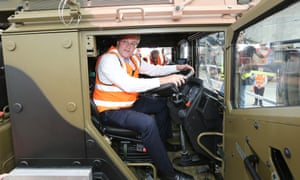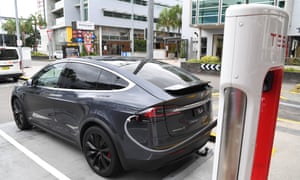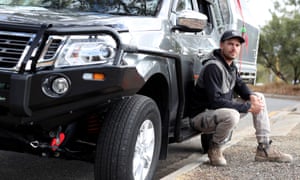Transport emissions should be falling with better technology, but
policy inertia has left Australian motorists – and the environment –
worse off
“An electric ute would be great,” Rhys Jones says from the driver’s
seat of his ute while waiting out the front of the work site.
“I don’t know how much it would cost in terms of set up and all that, but I’ve been on jobs where I’ve seen electric cars. They sneak up on ya. There’s no motor in them, so the engines run silent.”
Three months ago the 28-year-old South Australian carpenter bought a brand new 2019 Nissan Navara, NP300 dual cab ute. It cost $42,000, before he installed a new canopy to protect his tools, an upgraded suspension system, a winch, a bulbar and a scrub bar. With all the extras, the final price came to $58,000.
It was a decision Rhys says he made for work, though the set up meant he could also go camping, fishing and four-wheel-driving on the weekends with friends. That said, the job often makes it hard to get away. He works six days a week for his dad’s construction company, Monday-through-Saturday, and is usually on site from 7am every morning.
A read-out on the dash of his ute tells him he’s been burning diesel
at a rate of 11.4 litres every 100 kilometres. It doesn’t help that
Australian fuel is of such low quality the average person is paying $500
a year just to drive the country’s roads.
“It’s not fun paying for fuel,” Rhys says. “You’re basically burning money. Some people have different views on electric cars. On the way they were built, or how much energy they consume in that process.”
“I don’t mind ’em. I’m not out to save the world or anything, but I like trying to do the right thing by trying to stop fuel emissions and trying to stop global warming and all that. Little things that if everyone did them, would help.”
To date, however, the problem is that the choice in what vehicle to buy hasn’t been much of a choice at all, thanks to the lax Australian regulations governing fuel efficiency, CO2 emissions and fuel quality. Combined, these have worked to preserve the dominance of petrol engines in the market, while turning the car a person drives into an unlikely political issue.

“I don’t know how much it would cost in terms of set up and all that, but I’ve been on jobs where I’ve seen electric cars. They sneak up on ya. There’s no motor in them, so the engines run silent.”
Three months ago the 28-year-old South Australian carpenter bought a brand new 2019 Nissan Navara, NP300 dual cab ute. It cost $42,000, before he installed a new canopy to protect his tools, an upgraded suspension system, a winch, a bulbar and a scrub bar. With all the extras, the final price came to $58,000.
It was a decision Rhys says he made for work, though the set up meant he could also go camping, fishing and four-wheel-driving on the weekends with friends. That said, the job often makes it hard to get away. He works six days a week for his dad’s construction company, Monday-through-Saturday, and is usually on site from 7am every morning.
“It’s not fun paying for fuel,” Rhys says. “You’re basically burning money. Some people have different views on electric cars. On the way they were built, or how much energy they consume in that process.”
“I don’t mind ’em. I’m not out to save the world or anything, but I like trying to do the right thing by trying to stop fuel emissions and trying to stop global warming and all that. Little things that if everyone did them, would help.”
To date, however, the problem is that the choice in what vehicle to buy hasn’t been much of a choice at all, thanks to the lax Australian regulations governing fuel efficiency, CO2 emissions and fuel quality. Combined, these have worked to preserve the dominance of petrol engines in the market, while turning the car a person drives into an unlikely political issue.

“Bill Shorten wants to end the weekend, when it comes to his policy on electric vehicles. When you’ve got Australians who are out there in their four-wheel-drives, he wants to say ‘see you later’ to the SUV.”
Those who might have otherwise excused such comments as brash rhetoric ahead of a do-or-die federal election thought better a few days later when the then environment minister, Melissa Price, announced the Coalition government would wait until 2027 to lift standards governing the quality of the country’s petrol.
"Australia has no ongoing emissions testing program of its own."
Together the two events are indicative of the Coalition’s approach to road emissions.
All told there are 19.5m cars on Australian roads but the strategy for managing their CO2 emissions may be best described as “hands-off”.
The strategy has been to let other countries do the heavy lifting by relying on the passive transfer of technology as newer, more efficient cars are imported into Australia.
On the face of it, the official stats lend credence to the idea, showing average CO2 emissions from the cars on Australian roads have been falling modestly over time.
The catch, according to recent research by Robin Smit, adjunct professor at the University of Technology Sydney, is that those figures do not reflect lived reality.
“Australia has no ongoing emissions testing program of its own,” Smit says. “In fact it hasn’t conducted vehicle testing since 2008, so we don’t really know how our fleet performs in the real world.”

When Smit corrected the difference to take into account real-world conditions, he found that CO2 emissions from passenger cars in Australia had hardly been trending down until 2014 and began to grow from 2015.
“That directly contradicts the statement that our fleet average emissions are steadily going down on a per kilometre basis,” Smit says.
Dirty diesel
In fact, a separate study conducted by progressive thinktank the Australia Institute found vehicle emissions had risen 10% over the past decade as Australians had increasingly opted to purchase larger diesel vehicles.Report author Hugh Saddler, an energy expert and honorary associate professor with the Australian National University’s Crawford School of Public Policy, found annual carbon dioxide emissions from burning diesel increased by 21.7m tonnes between 2011 and 2018.
Diesel vehicles – mostly utes – have doubled their share of the light commercial vehicle market, and from a lower base tripled their share of household passenger car sales.
Saddler said governments and industry had improved fuel efficiency of heavy road freight vehicles but done little to lift the efficiency of light vehicles such as the work ute or family car.
One of the culprits for the uptick in purchases of these larger, dirtier vehicles may be what is known as the “leakage effect”. The effect was first seen in the US, where some states, led by California, introduced strict regulations governing fuel efficiency and CO2 emissions.
Carmakers in the US responded to the regulatory changes by splitting their product range, sending cars with newer, more efficient engines to those highly regulated states, while the older and dirtier models in the product line went to those those without.
The result was any beneficial CO2 emission reduction was cancelled out.

As a means of reducing transport emissions, regulating the trifecta of fuel quality, vehicle emissions standards and fuel efficiency represents a tried and tested strategy. The interaction between the three creates incentives for technological development while transitioning fleets to lower or zero-carbon status, but Australia appears to be failing on all three counts.
On fuel quality alone, Australia ranks 66th in the world and the worst among developed nations. Its record on fuel efficiency and emissions standards is worse.
Standards may cover 80% of the global car market, with the US having first introduced regulations back in 1975, but Australia has never had regulations for mandatory fuel efficiency or CO2 emissions – despite multiple calls for action.
In July, a Senate select committee recommended standards be introduced, along with a national electric vehicle strategy as a way to transition the fleet.
Policy inertia
An earlier edition of the Coalition government created a body called the Ministerial Forum on Vehicle Emissions to set standards on fuel-efficiency standards, fuel quality and CO2 emissions.Though the forum barely met in an official capacity, the research underpinning its work was performed in wide consultation with carmakers, industry bodies and a pantheon of relevant experts.
As the 2019 federal election approached, however, its work stalled entirely, says Behyad Jafari of the Electric Vehicles Council.
“We’d spent a number of years proactively working with the government for a long time,” Jafari says. “Then the government dropped it. Today it’s sitting there with no one working on it. It’s sitting on the top shelf, untouched.”
Jafari says the international investors he regularly speaks to have been shocked by Australia’s total lack of regulatory standards. While he says companies are continuing to invest in Australia, the country has fallen further down the priority list when it comes to deciding what cars get sent where.
"It’s high-school science. Rubbish in, rubbish out"
To date the federal government has been attempting to plug the policy vacuum by having a team within the environment department write a National Electric Vehicle Strategy.
The strategy will help manage the uptake of electric cars ahead of 2027 when they are projected to reach a tipping point in the market – the same year Australia is now pegged to get better-quality fuels.
It will help, says Tony Weber, the chief executive of the Federal Chamber of Automotive Industries, but without critical investment in basic infrastructure, Australia won’t catch up to the rest of the world.
“We cannot run the most advanced engines in the world that are coming out of the latest R&D because of the fuel quality,” Weber says. “Even in the transition to electric, people will buy plug-in hybrids first, which won’t run properly on Australian fuel.
“We can deliver the best-quality engines to Australian consumers, so long as we have the fuel to run them, but we don’t have the fuel. The two are interrelated. Better CO2 emissions are driven by better-quality fuel, so it’s high-school science. Rubbish in, rubbish out.”
Weber says the situation is “enormously frustrating” for car companies, especially as the government appears attuned to lobbying efforts run by the petrol refining industry which have “kicked up a fuss”.
It is a situation Weber says doesn’t need to exist, as the government could act any time, but so far it has simply decided not to. When asked why he thinks that is, Weber pauses for a moment before answering with a sigh.
“You’re asking the wrong bloke,” he says.

No comments:
Post a Comment